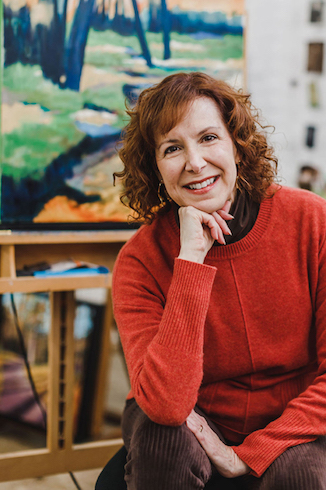Twenty years ago it would have been unthinkable for me to suggest that artists add shopping carts to their websites. Above all, it was crazy expensive to do so at the time. But also it was considered a bit tacky.
Boy have things changed! Not just since Covid, but even in the decade leading up to where we are now.

Online shopping carts are affordable and easy to implement, and the vast majority of the population is comfortable buying online—even buying art online. Some even prefer the online experience.
Then there are the galleries. Many of them struggle to make sales (again, even before Covid) and haven’t quite gotten the hang of social media. They were the last of the art world to come into the 21st century way of doing business.
But now even galleries are selling online, with mega-dealer David Zwirner leading the way in 2017.
Why wouldn’t you make it easier for people to buy directly from you?
That’s what Lynn Goldstein thought, too. She built a shopping cart for her website earlier this year. And the sales rolled in immediately after the March launch.
To date, Lynn has sold 18 original paintings and about a dozen reproductions directly from her site, and I wanted to find out how.
It must be said that neither Lynn nor I are not experts in all of the options you have for shopping carts. I wanted to share Lynn’s experience and, above all, her results.
Listen in if you’re curious about how she did it.
But first, a disclaimer. This was recorded on Instagram Live without the fancy microphone set-up. The sound quality isn’t great and my home editing is kind of choppy. But please look past that if you are considering putting e-commerce on your website.
Listen
Music by Wildermiss.
Highlights
- Why Lynn decided to install e-commerce now and how my Art Biz Accelerator figured into the equation. 2:44
- How Lynn decided on which shopping cart to use on her website. 4:09
- How she approached the tedious process of adding artwork to the backend of the cart, and the number of pieces available. 5:54
- Weebly was purchased by Square in 2019, which helps with the payment processing. 8:18
- What she left out of the shopping cart. 10:20

Lynn Goldstein painting in her Virginia studio. - A good relationship with her gallery is critical. How they felt about her e-commerce. 11:11
- How Lynn announced the online cart to her list and what she wishes she had known before doing so. 17:17 and 21:09
- Lynn culled her email list, keeping only the most engaged, and now has 600 people on there. 18:27
- Lynn has sold 18 originals and many reproductions from her website in just a few months. 25:58
- Trudy Rice, also a member of my mastermind, also tweaked her approach and started selling originals in addition to her homewares that were also selling well. 27:08
- What Lynn and I think about “competition” between artists. 27:31
- The price point that seems to be the the sweet spot for her online sales. 29:21
- How the Artist Support Pledge works. 30:10
- How Lynn handles shipping charges. 31:24
- Sales taxes can be confusing, but the system she selected figures them out for her. 36:01
- Lynn’s inventory is later updated in Artwork Archive. 39:21
- Q&A from people who were on the Instagram Live. Questions were about Lynn’s choice of email marketing software, packing procedures, and how to grow your list. 39:58
- Lynn prefers shipping U.S. Postal Service. 41:39
Mentioned
- Artists Support Pledge
- Trudy Rice
- Collector Relationship Essentials
- My Artists’ Masterminds < email me for more!
About My Guest
Lynn Goldstein is a painter and instructor who lives in Virginia—the Washington, D.C. metro area. Her work is steeped in nature, where she returns frequently to find comfort and inspiration for her art. She says her mission is “to help people feel peace amidst a troubled world and hectic daily lives.”
When not painting, Lynn can be found leading tours at the National Portrait Gallery (during normal times!).
Follow her on Instagram @lynngoldstein_art.
In Context
Mega-dealer David Zwirner led the way to online commerce for art when he opened virtual exhibitions in 2017 (just 3 years ago!). When Covid hit this year, he offered his platform to smaller galleries for their use.
Top artist Shantell Martin, whose site-specific work can currently be seen around the Denver Art Museum and elsewhere, sells everything from original art to pillow cases to sneakers on her website. (She also wrote a badass response to Microsoft’s botched invitation for her to create a mural in NYC during the Black Lives Matter protests.)
Music by Wildermiss.




5 thoughts on “The Art Biz ep. 58: Adding E-Commerce to Your Website with Lynn Goldstein”
Thank you for this podcast! I’ve also been wondering about adding prices to my website, so this podcast was particularly helpful.I’m curious if Lynn’s pricing is the same for online sales as it is through her gallery, or if she deducts for not having to pay a commission to a gallery. I would assume for ethical reasons, she keeps her pricing the same. So, I definitely don’t mean to be rude, but that means a 24×30 for 2500 is priced a bit on the low side. Does Lynn counter this by painting quickly and having a lot of inventory always on hand? Regardless, 18 paintings online in 3 months? Impressive!!
I can say with confidence that Lynn has consistent pricing, but I’ll let her respond more fully. Thanks for listening, Theresa.
Hi Teresa, Alyson is correct. My prices are the same no matter where the work is sold. This is indeed for ethical reasons. I didn’t remember saying that I sold a 24×30 inch piece for $2500. I can tell you that I have a tough time remembering prices and sizes on the fly. That’s why I usually have to tell potential buyers that I will get back to them with prices if we are simply speaking, and I don’t have my inventory in front of me. You are welcome to look at my website to see my prices. Thanks for listening to the podcast.
I appreciated this podcast! I just started my own store on my website due to covid and am still learning. One thing for listeners is to take a look at the tax issue. I don’t think it’s quite as hard as it sounds. This is what I learned from my research and I would love to be corrected if I’m wrong! I live in Washington so I do deal with sales taxes and yes, every area has a different tax level. However if you are selling out of state and do not have a physical presence in that state (store- not a gallery that just represents you), you only pay sales taxes to that state if you are doing over $100,000 worth of business in that state. So yes there was a law passed but it applies more to larger businesses (but if you are bringing in that much from out of state as an artist- then keep rocking it!) I use squarespace and it was easy to expand my site to include a sales page. It also gave me the option to include tax for any states I needed, so I set it up to charge tax in Washington. I used my own area tax rate which is around 8.6% and is on the lower sided for Washington. That means that someone from Seattle gets a 2% discount. I end up paying the difference when I calculate my quarterly taxes but it’s easier than trying to charge people for each area. I don’t have lots of local business so it’s easy to manage the quarterly taxes by hand.
Thanks as always!